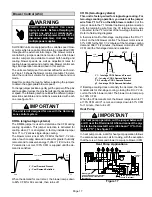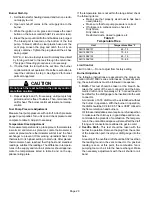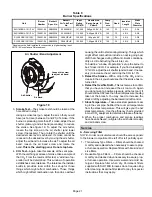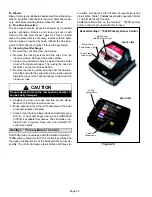
Page 8
Indoor Coil Placement
In cooling / heat pump applications, Lennox recommends that
the indoor coil be installed at least 4 inches above the top of the
furnace cabinet to allow proper airflow. If coil cabinet does not
provide proper clearance, use field−fabricated transition.
Venting
WARNING
Combustion air openings in front of the furnace must
be kept free of obstructions. Any obstruction will
cause improper burner operation and may result in
a fire hazard.
WARNING
The barometric draft control shall be in the same at-
mospheric pressure zone as the combustion air inlet
to the furnace. Deviation from this practice will cause
improper burner operation and may result in a fire
hazard.
CAUTION
Do not store combustible materials near the furnace
or supply air ducts. The material (such as paint, mo-
tor oil, gasoline, paint thinner, etc.) may ignite by
spontaneous combustion creating a fire hazard.
WARNING
This furnace is certified for use with type L" vent.
B" vent must not be used with oil furnaces.
Prior to installation of unit, make a thorough inspection of the
chimney to determine whether repairs are necessary. Make
sure the chimney is properly constructed and sized accord-
ing to the requirements of the National Fire Protection Asso-
ciation. The smallest dimensions of the chimney should be
at least equal to the diameter of the furnace vent connector.
Make sure the chimney will produce a steady draft sufficient
to remove all the products of combustion from the furnace. A
draft of at least .04" w.c. (9.9 Pa) is required during burner
operation.
1 − Local building codes may have more stringent installa-
tion requirements and should be consulted before
installation of unit.
2 − The vent connector should be as short as possible to
do the job.
3 − The vent connector should not be smaller than the out-
let diameter of the vent outlet of the furnace.
4 − Pipe should be at least 24 gauge galvanized.
5 − Single wall vent pipe should not run outside or through
any unconditioned space.
6 − Chimney should extend 3 feet (0.9 m) above highest
point where the vent passes through the roof, and 2
feet (0.6 m) higher than any portion of a building within
a horizontal distance of 10 feet (3 m).
7 − The vent must not pass through a floor or ceiling.
Clearances to single wall vent pipe should be no less
than 6" (152 mm); more if local codes require it.
8 − The vent may pass through a wall where provisions
have been made for a thimble as specified in the Stan-
dards of the National Board of Fire Underwriters. See fig-
ure 8.
Wall Thimble
Figure 8
Thimble
Vent Pipe
Combustible
Wall









































